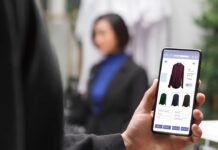New research by SaaS technology company Eagle Eye has found that retailers are failing to take advantage of widespread mobile phone use to enhance the customer experience. Results revealed that while consumers are frequently using their phone whilst shopping, they report hardly ever using it to interact with the retailer itself, and want to be offered more mobile enablement.
The statistics showed that most consumers have their smartphones in their hand as they shop, with 60 per cent of consumers using their mobile for some purpose as they walk around the store. The findings also revealed that shoppers were much more likely to use their mobiles socially, rather than to engage with the brand or enhance their experience. This was particularly true of young consumers, aged 16-24, who reported using their phones to send messages and make calls (48 per cent), listen to music (42 per cent) and check social media (37 per cent). However, a much smaller number reported using it to interact with the retailer: 17 per cent to locate a product in store, 17 per cent to redeem a promotion and 15 per cent to pay for products.
Smartphones are clearly being used in stores, yet retailers are still not tapping into this key channel to engage with their shoppers as they go around the aisles. Yet, this isn’t due to a lack of digital appetite. On the contrary, the Eagle Eye statistics showed that consumers are receptive to receiving mobile promotions: 68 per cent of consumers said they would find it helpful to be sent discount vouchers to their phone while shopping. Meanwhile, over half (55 per cent) said they would consider downloading an app if it made it easier to pay and redeem promotions in store.
‘Consumers always have their phone in their hand, and our research shows that when they’re shopping they’re using it for everything but communicating with the retailer. The store is the only destination where people put their phone back in their pocket because all digital enablement stops at the entrance. Retailers are missing out on a huge opportunity to speak to their customers more directly,’ says Tim Mason, CEO of Eagle Eye.
The statistics also revealed a continued gap between the physical and digital shopping experience, despite an omnichannel strategy being at the forefront of most retailers’ minds. The research shows that many consumers are still experiencing frustrations and disconnect. 61 per cent reported having gone to a retail store to look for a specific product that they had seen online, but found it to be out of stock. 42 per cent of consumers said it would improve their shopping experience to be offered an app that allowed them to see in store availability before visiting. Once again, retailers are missing a gap in the market that could be filled with digital enablement.
‘The omnichannel experience is still somewhat elusive for today’s retailers,’ continues Mason. ‘It’s unacceptable that customers are still actively noticing disparities between what they see online and what they see in store. It’s time for brands to bridge the gap, connecting these experiences via the smartphone to create a seamless customer journey across channels.’
2,000 adults from England, Scotland and Wales participated in the study. The survey was drafted by Eagle Eye and the data was outsourced and gathered in March 2017 by Censuswide, an online research database which polled the respondents on our behalf.

















